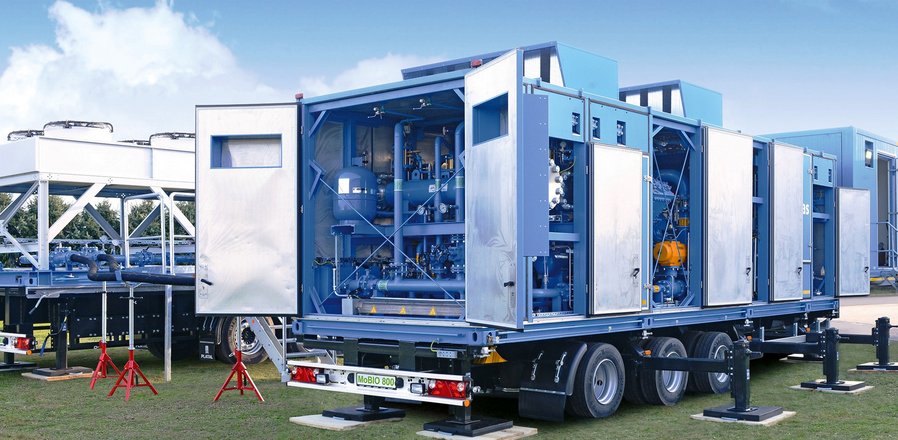
Weather-caused fluctuations of wind and sun are part of the major challenges for the energy infrastructure of the future. Storage contributes to the successful cushioning of these fluctuations. CO2-neutral gas from biomass fortunately is not subject to these fluctuations and achieves in excess of 80 % annual full load equivalent. This is equivalent to five times as much as photovoltaics. Currently, biomethane with an energy content of 10 TWh is fed into the natural gas grid annually in Germany. The various scenarios plan 90-110 TWh biomethane feed for 2030. This would, for example, secure the heat supply for 30 % of all German households. Thus, biomethane provides an important contribution for a functioning dual energy carrier world based on electricity and gas from renewable sources.
NEUMAN & ESSER offers a wide range of proven solutions for the gas grid feed area, which incorporates both stationary and mobile (compressors on trailers) variants. Normally, the feed pressures are approximately 25, 45 and 70 bar(g), dependent on the prevailing gas grid. The transport capabilities vary between 350 and 6,000 Nm3/h, therefore considerably higher than those for biogas applications for combined heat and power plants. Depending upon whether the piston compressor is directly integrated after gas treatment downstream of the fermenter or pre-compression takes place via an upstream screw compressor, suction pressure is 1.5 – 10 bar(a). Pressure-resistant and gastight crankcases ensure emission-free compression, thus contributing directly to climate protection.
The mentioned process parameters demonstrate the huge range of such a system, which often cannot be precisely determined by the plant operator at the beginning of the project. In particular, suction pressure plays an important role as system design can be considerably more efficiently if the suction pressure range can be limited to the de-facto needs. NEUMAN & ESSER supports and consults its customers here.

Last but not least, the controllability of a compressor plant has special significance due to the described variance. Often, it is only possible to realize the entire process range with one system by combining several control concepts. Speed control via frequency converters, bypass regulation, suction valve unloading or (variable) clearance pockets are the tools which can be combined here. When selecting them, the energy efficiency of the individual methods plays a decisive role. With the current electricity mix in Germany each kilowatt hour of electrical energy saved when compressing means half a kilogram less CO2 emissions into the atmosphere. With an intelligent control concept, a small biomethane compressor station with some 600 Nm3/h achieves annual CO2 savings of 80,000 kg and simultaneously saves an additional € 30,000 in energy costs.

NEUMAN & ESSER customers often wish to be provided with a so-called turnkey solution, i.e. the entire scope is provided ready to use and from one single source. This includes solutions which exceed the normal scope of delivery of a compressor system by far. If desired, NEUMAN & ESSER also provides the compressor system housings, gas warning systems as well as a pre-compression via screw compressors. Should the system requirements or process parameters change in the future, the NEUMAN & ESSER revamp team offers numerous options for expert revamping of the system. Support during the entire life cycle of such a system in combination with corresponding service and maintenance contracts is part and parcel of the daily business.